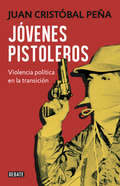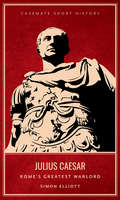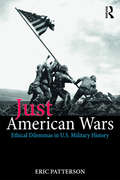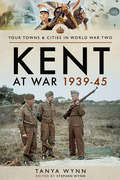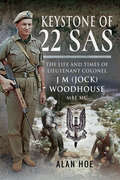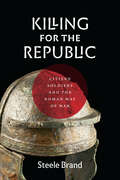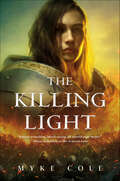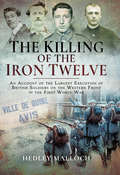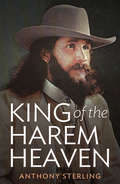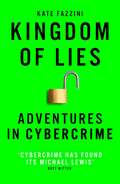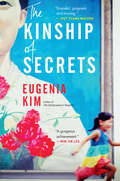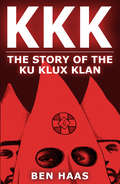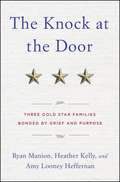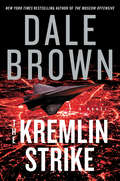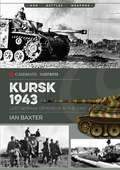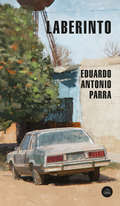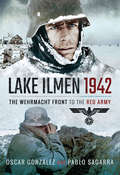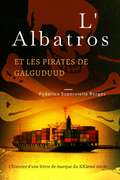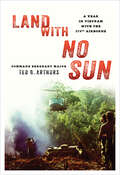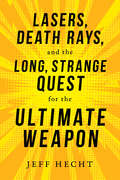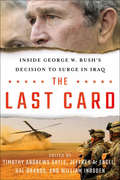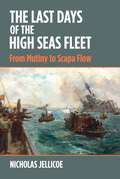- Table View
- List View
Jóvenes pistoleros: Violencia política en la transición
by Juan Cristóbal PeñaEn su nuevo libro, el destacado cronista chileno indaga en la vida y obra de Ricardo Palma Salamanca y sus cercanos A partir de su propia trayectoria vital, Juan Cristobal Peña rememora la vida de Ricardo Palma Salamanca y de Miska Brzovic, su pareja, a quien el autor de este libro conoció durante la educación secundaria. Entrecruzando sus recuerdos con los hechos y acontecimientos que dieron fama a ambos jóvenes, Peña reconstruye un periodo turbulento de nuestra historia reciente, que parte con las marchas y protestas estudiantiles a mediados de los ochenta y que se extiende hasta hoy, con Palma Salamanca viviendo en París luego de salir a la luz su cinematográfica y clandestina vida fuera de Chile.
Julius Caesar: Rome's Greatest Warlord (Casemate Short History)
by Simon ElliottA look at the remarkable military career of ancient Rome&’s most celebrated leader. Born into an aristocratic family, Julius Caesar has been an inspiration to countless military commanders over the past two millennia. His early military campaigns, part of his progression along the cursus honorum, ranged from the East to Spain to the early Roman civil wars. His participation in the Gallic Wars as well as his incursions into Britain are known mainly through his own published commentary on said events. Written by a prominent historian and archaeologist, this concise volume details Caesar&’s military life and the role it played in his political career. From his youth through the civil wars that resulted in his becoming the dictator of Rome, Caesar has left a remarkable legacy.
Just American Wars: Ethical Dilemmas in U.S. Military History (War, Conflict and Ethics)
by Eric PattersonThis book examines the moral choices faced by U.S. political and military leaders in deciding when and how to employ force, from the American Revolution to the present day. Specifically, the book looks at discrete ethical dilemmas in various American conflicts from a just war perspective. For example, was the casus belli of the American Revolution just, and more specifically, was the Continental Congress a "legitimate" political authority? Was it just for Truman to drop the atomic bomb on Japan? How much of a role did the egos of Kennedy, Johnson and Nixon play in prolonging the Vietnam War? Often there are trade-offs that civilian and military leaders must take into account, such as General Scott’s 1847 decision to bombard the city of Veracruz in order to quickly move his troops off the malarial Mexican coast. The book also considers the moral significance and policy practicalities of different motives and courses of action. The case studies provided highlight the nuances and even limits of just war principles, such as just cause, right intention, legitimate authority, last resort, likelihood of success, discrimination, and proportionality, and principles for ending war such as order, justice, and conciliation. This book will be of interest for students of just war theory, ethics, philosophy, American history and military history more generally.
Keeping a Warrior (Loving a Warrior #2)
by Melanie HansenSometimes the only hope for the walking wounded is in each other’s arms.Devon Lowe is a survivor.A survivor of war. Of combat. And of a betrayal by men she considered her brothers-in-arms. But her trailblazing work as a Cultural Support Team member working alongside the navy SEALs is too important for her to back down now.Fresh off a painful breakup, air force pararescueman Rhys Halloran recognizes Devon’s trauma for what it is—something that’s left her isolated but far from irreparably damaged.With Devon’s trust still lying shattered back in Afghanistan, putting her faith in a man who’s nursing a broken heart isn’t easy. But she’s tired of people making her feel weak, and Rhys makes her feel anything but, sparking a heated attraction that was never part of the plan.With all eyes on Devon to prove herself in a brutal man’s world, having it all will mean putting her heart on the line like never before. But when it comes to Rhys, it’s an uphill battle she’s ready to fight.Publisher’s Note: Keeping a Warrior deals with topics some readers may find difficult, including past sexual assault.This book is approximately 92,000 wordsOne-click with confidence. This title is part of the Carina Press Romance Promise: all the romance you’re looking for with an HEA/HFN. It’s a promise!
Keeping Her Close: A Clean Romance (A Pacific Cove Romance #3)
by Carol RossHired to protect her…unable to resist herThe job sounds simple: teach a businessman’s daughter how to stay safe. But former navy SEAL turned bodyguard Kyle Frasier has a personal motive, too. Harper Jansen is his late best friend’s fiancée. Loyalty demands he protect her, not that Harper looks in need of rescuing. In fact, it’s Kyle who needs help—balancing duty with his desire to build a life with the one woman he shouldn’t want…
Kent at War 1939–45 (Your Towns & Cities in World War Two)
by Tanya WynnThis comprehensive account of the southern English county during WWII covers everything from the Dunkirk evacuations to the Battle of Britain and more. Located along the English Channel, the southeastern county of Kent played a significant role in the Second World War. This volume covers Kent&’s many contributions—both civilian and military—throughout the conflict. The chronicle details how the Dover Patrol kept Allied shipping safe in the English Channel, as well as the preparation and aftermath of the Dunkirk evacuations of May 1940, with all of the vessels leaving from and returning to Kent ports and harbors. Kent&’s numerous airfields were of vital importance during the Battle of Britain between July and October 1940. The Richborough camp, set up in 1939 at the old First World War Kitchener barracks, provided safe haven to thousands of German and Austrian Jewish refugees. This book includes never before published letters written to one of the camps residents during his stay there. Historian Tanya Wynn also discusses the county's military hospitals and pow camps, it&’s Victorian Cross and George Medal winners, and the restricted areas that adorned the coast as the people of Kent battened down the hatches, knowing that they were the very first line of defense in case of a German invasion.
Keystone of 22 SAS: The Life and Times of Lieutenant Colonel J. M. (Jock) Woodhouse MBE MC
by Alan HoeThis British military biography tells the full story of the Lieutenant Colonel who helped turn the 22nd SAS into the world&’s leading special forces unit. Despite its successes during World War II, the future of the British Army&’s Special Air Service was uncertain for years afterward. In the 1950s, it was resurrected as the 22nd SAS Regiment to take part in the Malayan Emergency, and over time evolved into one of the British military&’s most important units. This renaissance was brought about by a small group of highly motivated officers. Of these, Lieutenant Colonel John Woodhouse stood out for his energy, expertise, and courage. Written by an SAS insider, this biography demonstrates how Woodhouse played a pivotal role in transforming the 22nd SAS into an elite fighting force. Woodhouse led the regiment through campaigns in Oman, Borneo, Radfan and South Arabia, as it built its unrivaled reputation. After leaving the Army, Woodhouse became a sought-after counter-terrorist consultant taking an advisory and active role in operations worldwide. While Colonel Sir David Stirling publicly acknowledged Woodhouse as a cofounder of the 22nd SAS, the full story of his role has not been widely recognized. As this fascinating book reveals, without his efforts there would probably be no 22nd SAS today.
Killing for the Republic: Citizen-Soldiers and the Roman Way of War
by Steele BrandHow Rome's citizen-soldiers conquered the world—and why this militaristic ideal still has a place in America today."For who is so worthless or indolent as not to wish to know by what means and under what system of polity the Romans... succeeded in subjecting nearly the whole inhabited world to their sole government—a thing unique in history?"—PolybiusThe year 146 BC marked the brutal end to the Roman Republic's 118-year struggle for the western Mediterranean. Breaching the walls of their great enemy, Carthage, Roman troops slaughtered countless citizens, enslaved those who survived, and leveled the 700-year-old city. That same year in the east, Rome destroyed Corinth and subdued Greece. Over little more than a century, Rome's triumphant armies of citizen-soldiers had shocked the world by conquering all of its neighbors. How did armies made up of citizen-soldiers manage to pull off such a major triumph? And what made the republic so powerful? In Killing for the Republic, Steele Brand explains how Rome transformed average farmers into ambitious killers capable of conquering the entire Mediterranean. Rome instilled something violent and vicious in its soldiers, making them more effective than other empire builders. Unlike the Assyrians, Persians, and Macedonians, it fought with part-timers. Examining the relationship between the republican spirit and the citizen-soldier, Brand argues that Roman republican values and institutions prepared common men for the rigors and horrors of war. Brand reconstructs five separate battles—representative moments in Rome's constitutional and cultural evolution that saw its citizen-soldiers encounter the best warriors of the day, from marauding Gauls and the Alps-crossing Hannibal to the heirs of Alexander the Great. A sweeping political and cultural history, Killing for the Republic closes with a compelling argument in favor of resurrecting the citizen-soldier ideal in modern America.
The Killing Light (The Sacred Throne #3)
by Myke ColeThe thrilling conclusion to Myke Cole's Sacred Throne trilogyHeloise and her allies are marching on the Imperial Capital. The villagers, the Kipti, and the Red Lords are united only in their loyalty to Heloise, though dissenting voices are many and they are loud. The unstable alliance faces internal conflicts and external strife, yet they’re united in their common goal. But when the first of the devils start pouring through a rent in the veil between worlds, Heloise must strike a bargain with an unlikely ally, or doom her people to death and her world to ruin. Praise for the Sacred Throne Trilogy"A heart-wrenching, blood-racing, all-around page-turner. Spare, vivid and surprisingly sensual, with a small, fierce heroine who will stick in your mind and live in your soul."—Diana Gabaldon"Ruthless and heart-wrenching." —Robin HobbThe Sacred Throne TrilogyThe Armored SaintThe Queen of CrowsThe Killing LightAt the Publisher's request, this title is being sold without Digital Rights Management Software (DRM) applied.
The Killing of the Iron Twelve: An Account of the Largest Execution of British Soldiers on the Western Front in the First World War
by Hedley Malloch&“[A] compelling read . . . Highly recommended for its extraordinarily powerful insight into the fragged edges of the first months of the European War.&” —The Western Front Association Why did the Germans brutally and illegally execute a group of British soldiers who had been trapped behind the lines during the retreat to the Marne in 1914? Hedley Malloch, in this gripping and meticulously researched account, vividly describes the fate the soldiers on the run, and of the French civilians who sheltered them. He tells a dramatic and tragic story of escape, betrayals and punishment that also gives a fascinating insight into the life stories of the soldiers and civilians involved and the mind-set of the German army on the Western Front. The book names the German officers responsible for this atrocity and explores their motivations. &“This is an episode of WW1 with which I am not familiar, and one that I found particularly fascinating and, at the same time, harrowing. The author attempts to set the record straight by naming the perpetrators of this enormous outrage.&” —Books Monthly &“Hedley Malloch, who is chair of the Iron Memorial fund and Honorary Life Member of the RMFA, has done a wonderful job with his book, a true memorial in its own right to those that were executed; innocent soldiers who just happened to find themselves on the wrong side of the lines.&” —Redcoat and Khaki &“If you have a Top Ten &‘books on the First World War&’—then make room for The Killing of the Iron Twelve by Hedley Malloch.&” —The Western Front Association
King of the Harem Heaven: The Amazing True Story of A Daring Charlatan Who Ran A Virgin Love Cult In America
by Anthony SterlingKing Of The Harem Heaven, first published in 1960, is the fascinating, although likely somewhat sensationalized story, of the House of David religious cult and its leader, Benjamin Franklin Purnell. Based in Benton Harbor, Michigan, the group also owned a large tract of land on High Island in Lake Michigan, and eventually developed a number of successful enterprises including farms, timber, a vegetarian restaurant, amusement park, roadside service station, and a motel. Notable was their having several baseball teams, the “Flying Rollers,” famous for their long hair and beards (they did not believe in cutting their hair) which toured the U.S. and played against other semi-pro teams. The group was rocked by scandal when members alleged that leader Purnell, while enforcing celibacy among the members, was engaging in sex with the women—including underage teenagers—of the group, and also for massive financial irregularities. Legal battles ensued, ending only upon the death of Purnell in December 1927.
Kingdom of Lies: Unnerving adventures in the world of cybercrime
by Kate FazziniWould you say your phone is safe, or your computer? What about your car? Or your bank? There is a global war going on and the next target could be anyone – an international corporation or a randomly selected individual. From cybercrime villages in Romania to intellectual property theft campaigns in China, these are the true stories of the hackers behind some of the largest cyberattacks in history and those committed to stopping them. You&’ve never heard of them and you&’re not getting their real names. Kate Fazzini has met the hackers who create new cyberweapons, hack sports cars and develop ransomware capable of stopping international banks in their tracks. Kingdom of Lies is a fast-paced look at technological innovations that were mere fantasy only a few years ago, but now make up an integral part of all our lives.
The Kinship of Secrets
by Eugenia Kim"A gorgeous achievement.&”—Min Jin Lee, author of Pachinko From the author of The Calligrapher&’s Daughter comes the riveting story of two sisters, one raised in the United States, the other in South Korea, and the family that bound them together even as the Korean War kept them apart. In 1948 Najin and Calvin Cho, with their young daughter Miran, travel from South Korea to the United States in search of new opportunities. Wary of the challenges they know will face them, Najin and Calvin make the difficult decision to leave their infant daughter, Inja, behind with their extended family; soon, they hope, they will return to her. But then war breaks out in Korea, and there is no end in sight to the separation. Miran grows up in prosperous American suburbia, under the shadow of the daughter left behind, as Inja grapples in her war-torn land with ties to a family she doesn&’t remember. Najin and Calvin desperately seek a reunion with Inja, but are the bonds of love strong enough to reconnect their family over distance, time, and war? And as deep family secrets are revealed, will everything they long for be upended? Told through the alternating perspectives of the distanced sisters, and inspired by a true story, The Kinship of Secrets explores the cruelty of war, the power of hope, and what it means to be a sister.
KKK: The Story of the Klu Klux Klan
by Ben HaasKKK: The Story of the Ku Klux Klan, first published in 1963, sets out to answer three questions about the KKK: what it is, why was it so hard to eradicate from American society, especially in the southern states; and how powerful is the Klan (at the time of the book’s publication). Through his extensive research and interviews with Klan leaders as well as knowledgeable outsiders, author Ben Haas attempts to answer these questions and provide insight into the origins, beliefs, and activities of this secret society.AS LONG AS THERE’S HATEKLANSMEN WILL RIDEThis is the frightening conclusion suggested by Ben Haas’ study of the Ku Klux Klan, yesterday, today, and until... Even as the House Committee on Un-American Activities, spurred on by the anger of President Johnson, investigates the midnight tyranny of the Klan’s “enforcers,” doubt is justified whether the whole monstrous picture of the Klan’s stubborn vitality can be dragged into the day light...and whether its flaming crosses will ever be doused. Avid “Americanism” and pious “old-time religion” bolster the vicious, fear-driven bigotry that may even today be spreading and solidifying its cruel grip on the nation. Here is the story of the hooded hate-mongers and their......INVISIBLE EMPIRE OF TERRORROUGHSHOD BIGOTRY..,THE MEN, THE MINDS, THE TRADITIONFrom its birth in the ashes of the Civil War to its resurgence in the heat of today’s civil rights struggle, here is the story of the Klan. It is a horror story told with scathing humor; a non-fiction nightmare detailed by a journalist who has interviewed present Klan leaders and dug for the truth behind their claims. Here is the face and the shape of the sprawling white monster that seemingly will not die.
The Knock at the Door: Three Gold Star Families Bonded by Grief and Purpose
by Ryan Manion Heather Kelly Amy LooneyThree Gold Star women, linked forever by unimaginable loss, share their inspiring, unlikely journey that began on the worst day of their lives.What happens when tragedy knocks on your front door? For us, it was a literal knock, with two men standing in crisply pressed uniforms. They had news. News that gutted us to the core -- the death of our loved ones, a brother and two husbands -- in combat zones. The thing about those moments is that it's almost inconceivable that they can happen to you. That is, until they do.This book is for anyone who has ever received a knock at the door. And if you live long enough and have the courage to love others, you will. Maybe it's a cancer diagnosis. Maybe it's the death of your best friend. The betrayal of a spouse. The loss of a child. The implosion of a professional career. Or any tragedy that takes the person we love the most away from us too soon. Life is not without its challenges. The key is how you respond.This is our story. The story of three women, bonded by grief and purpose. Grief because we lost our best friends in war. Purpose because we resolved -- together -- to do something about it. To turn loss into inspiration for others and to channel the love that we had for the men in our lives into love for others through service. It was the only way we could escape the trap of despair and inaction, and we believe it offers a roadmap for anyone else who has ever had to answer a knock at the door.
The Kremlin Strike: A Novel (Brad McLanahan #5)
by Dale BrownIn this exciting, visionary, and all-too-plausible next chapter in the legendary Dale Brown’s New York Times bestselling techno-warfare series, Brad McLanahan and the Iron Wolf Squadron must fight the Russians on a dangerous, untested battlefield: outer space.The previous administration’s ineffective response to the growing Russian threat has left America vulnerable. Setting a bold course for America’s defense, the decisive and strong new president, John Dalton Farrell, intends to challenge Russian aggression head on. Brad and Patrick McLanahan and the formidable Iron Wolf Squadron—including the recently injured Nadia Roz, rested and back to fighting form thanks to a pair of state-of-the-art prosthetic legs—are ready and eager to join the battle. But even with their combined forces, the Russian menace may prove too great for the Americans to overcome. Done with provocative skirmishes and playing for small stakes, the Russian president has set his sights on the ultimate prize: controlling the entire world. Expanding beyond earth’s bounds, the Russians have built a new high-tech space station and armed it with weaponry capable of destroying US satellites as well as powerful missiles pointed at strategic targets across earth.Devising a cunning plan of attack, Brad, Nadia, and the Iron Wolf warriors will take to the skies in their advanced space planes to destroy the space station, check the Russians’ plan for dominance, and save the world. But is it already too late?
Kursk 1943: Last German Offensive in the East (Casemate Illustrated #Cis0014)
by Ian BaxterAn illustrated history of World War II&’s largest tank battle that went down near the Russian city. In the summer of 1943, Nazi Germany launched Operation Zitadelle (Citadel), aimed at cutting off Soviet forces in the Kursk salient. This offensive resulted in the Battle of Kursk. Kursk quickly became a fierce contest of attrition, as Wehrmacht and elite Waffen-SS Panzer-Divisions with their powerful Tiger and Panther tanks unsuccessfully tried to hammer their way through the intricate lines of strong Soviet defensive positions. What followed was unabated fighting for two weeks as German units were slowly and systematically ground down in a series of brutal armored battles. During this ferocious fighting the Red Army savagely contested every foot of ground, finally ending German invincibility forever. For the first time in its short history, the blitzkrieg concept had failed. The reverberations caused by the defeat at Kursk were immense, and never again did the German war machine go on the offensive in the East. Stiff defensive action was now the stratagem placed upon the dwindling Panzerwaffe right to the gates of Berlin. With comprehensive captions and text, Kursk 1943 tells the story of this dramatic battle using rare and unpublished photographs, maps, and highly detailed artist profiles. The book reveals the events leading up to the battle in the first half of 1943 and the buildup of forces by both sides before their climatic showdown at Kursk.
Laberinto
by Eduardo Antonio Parra«La escritura de Parra mira con hondura y belleza nuestros terrenos extremos, violenta la ceniza para que el brillo asome.» Mónica Lavín Dos náufragos, dos supervivientes con más ganas de ahogarse de verdad que de seguir respirando, se encuentran una noche en un bar. Se conocen de tiempo atrás, de cuando eran otros. Uno fue profesor de literatura y entrenador de futbol, el otro fue su alumno. Ahora, beben con la misma feroz disciplina, para apagar la memoria, pero ésta se alimenta de un dolor demasiado vivo: de una noche, hace nueve años, en la que dos bandas rivales de narcotraficantes acabaron con su pueblo. Primero llegaron mensajes a los celulares. No era la primera vez: los narcos anunciaban el toque de queda e inmediatamente después cortaban las comunicaciones. Darío alcanzó a llegar a salvo a casa de sus padres con Norma, su novia. Pero no estaba Santiago, su hermano menor. Desoyendo las súplicas de su familia, decidió salir con Norma a buscar a Santiago. Así empezó su oscura odisea, que no habría de terminar nunca, porque el viaje mismo sería la destrucción de la verde Ítaca. Esta novela es un brillante artificio literario, un laberinto de ecos y, a la vez, el implacable testimonio de la desolación que la voracidad del narcotráfico ha sembrado en el norte de nuestro país.
Lake Ilmen, 1942: The Wehrmacht Front to the Red Army
by Óscar González Pablo SagarraThis WWII combat history sheds light on the Battle for Staraya Russa, in which German soldiers and Spanish volunteers bitterly fought the Red Army. In January 1942, in the Staraya Russa sector south of Lake Ilmen, the 16th German Army clashed with Vasili Morozov's 11th Soviet Army for possession of the region. Fighting alongside the Germans were the Spanish volunteers of the Blue Division. Though the fighting lasted for nearly a month, the battle for Staraya Russa is all but forgotten in studies of the Second World War&’s Eastern Front. In Lake Ilmen, 1942, the authors present a strategic framework of the battle from both the German and Russian perspectives. They also recount the hard fighting and extreme weather endured by both sides, bringing the human aspect of the conflict to life through a survey of individual volunteers who fought in it.
L'Albatros et les pirates de Galguduud: L'histoire d'une lettre de marque du XXIème siècle
by Federico Supervielle BergésLes camps de pirates qui parsèment la côte somalienne menacent de détourner tout bateau qui s'approche d'eux, mais les pays développés ne semblent pas capables de faire face à ce problème. L'industrie mondiale de l'énergie est sur le point de s'effondrer : un homme d'affaires sera-t-il capable de faire face aux pirates ? l'État somalien en faillite sera-t-il capable de contrôler ses propres côtes ? Un jeune marin de Cadix, fuyant ses problèmes personnels, est choisi pour en finir avec les ennemis du magnat, mais même l'océan Indien n'est pas assez loin de son passé. Au fur et à mesure que les événements se déroulent, il pressent un complot plus complexe derrière les attaques. Sans s'en rendre compte, Pablo est entraîné au centre d'une conspiration internationale dans laquelle il ne peut compter que sur l'aide de so,n équipage et de son navire : l'Albatros.
Land With No Sun: A Year in Vietnam with the 173rd Airborne
by Commander Ted G ArthursA no-holds-barred, straight-in-your-face account of combat in VietnamYou know it's going to be hot when your brigade is referred to as a Fireball unit. From May 1967 through May 1968, Ted Arthurs was in the thick of it, humping an eighty-pound rucksack through triple canopy jungle, chasing down the Viet Cong and North Vietnamese in the Central Highlands of South Vietnam. As sergeant major for a battalion of 800 men, it was his job to see them through this jungle hell and get them back home again.
Lasers, Death Rays, and the Long, Strange Quest for the Ultimate Weapon
by Jeff HechtThe whole story of laser weapons with a focus on its many interesting characters and sometimes bizarre schemesThe laser--a milestone invention of the mid-twentieth century--quickly captured the imagination of the Pentagon as the key to the ultimate weapon. Veteran science writer Jeff Hecht tells the inside story of the adventures and misadventures of scientists and military strategists as they exerted Herculean though often futile efforts to adapt the laser for military uses. From the 1950s' sci-fi vision of the "death ray," through the Reagan administration's "Star Wars" missile defense system, to more promising developments today, Hecht provides an entertaining history. As the author illustrates, there has always been a great deal of enthusiasm and false starts surrounding lasers. He describes a giant laser that filled a Boeing 747, lasers powered like rocket engines, plans for an orbiting fleet of robotic laser battle stations to destroy nuclear missiles, claims that nuclear bombs could produce intense X-ray laser beams, and a scheme to bounce laser beams off giant orbiting relay mirrors. Those far-out ideas remain science fiction. Meanwhile, in civilian sectors, the laser is already being successfully used in fiber optic cables, scanners, medical devices, and industrial cutting tools. Now those laser cutting tools are leading to a new generation of laser weapons that just might stop insurgent rockets. Replete with interesting characters, bizarre schemes, and wonderful inventions, this is a well-told tale about the evolution of technology and the reaches of human ambition.
The Last Card: Inside George W. Bush's Decision to Surge in Iraq
This is the real story of how George W. Bush came to double-down on Iraq in the highest stakes gamble of his entire presidency. Drawing on extensive interviews with nearly thirty senior officials, including President Bush himself, The Last Card offers an unprecedented look into the process by which Bush overruled much of the military leadership and many of his trusted advisors, and authorized the deployment of roughly 30,000 additional troops to the warzone in a bid to save Iraq from collapse in 2007.The adoption of a new counterinsurgency strategy and surge of new troops into Iraq altered the American posture in the Middle East for a decade to come. In The Last Card we have access to the deliberations among the decision-makers on Bush's national security team as they embarked on that course. In their own words, President George W. Bush, Vice President Dick Cheney, National Security Advisor Stephen Hadley, Secretary of State Condoleezza Rice, White House Chief of Staff Joshua Bolten, Secretary of Defense Robert Gates, and others, recount the debates and disputes that informed the process as President Bush weighed the historical lessons of Vietnam against the perceived strategic imperatives in the Middle East. For a president who had earlier vowed never to dictate military strategy to generals, the deliberations in the Oval Office and Situation Room in 2006 constituted a trying and fateful moment.Even a president at war is bound by rules of consensus and limited by the risk of constitutional crisis. What is to be achieved in the warzone must also be possible in Washington, D.C. Bush risked losing public esteem and courted political ruin by refusing to disengage from the costly war in Iraq. The Last Card is a portrait of leadership—firm and daring if flawed—in the Bush White House.The personal perspectives from men and women who served at the White House, Foggy Bottom, the Pentagon, and in Baghdad, are complemented by critical assessments written by leading scholars in the field of international security. Taken together, the candid interviews and probing essays are a first draft of the history of the surge and new chapter in the history of the American presidency.
The Last Collection: A Novel of Elsa Schiaparelli and Coco Chanel
by Jeanne MackinAn American woman becomes entangled in the intense rivalry between iconic fashion designers Coco Chanel and Elsa Schiaparelli in this captivating novel from the acclaimed author of The Beautiful American.Paris, 1938. Coco Chanel and Elsa Schiaparelli are fighting for recognition as the most successful and influential fashion designer in France, and their rivalry is already legendary. They oppose each other at every turn, in both their politics and their designs: Chanel’s are classic, elegant, and practical; Schiaparelli’s bold, experimental, and surreal.When Lily Sutter, a recently widowed young American teacher, visits her brother, Charlie, in Paris, he insists on buying her a couture dress—a Chanel. Lily, however, prefers a Schiaparelli. Charlie’s beautiful and socially prominent girlfriend soon begins wearing Schiaparelli’s designs as well, and much of Paris follows in her footsteps. Schiaparelli offers budding artist Lily a job at her store, and Lily finds herself increasingly involved with Schiaparelli and Chanel’s personal war. Their fierce competition reaches new and dangerous heights as the Nazis and the looming threat of World War II bear down on Paris.
The Last Days of the High Seas Fleet: From Mutiny to Scapa Flow
by Nicholas C. Jellicoe&“Much fresh material . . . an excellent historical narrative of the events leading up to the Great Scuttle, the terrible day itself and its aftermath.&” —Warships: International Fleet Review On June 21, 1919, the ships of the German High Seas Fleet—interned at Scapa Flow since the Armistice—began to founder, taking their British custodians completely by surprise. In breach of agreed terms, the fleet dramatically scuttled itself, in a well-planned operation that consigned nearly half a million tons, and 54 of 72 ships, to the bottom of the sheltered anchorage in a gesture of Wagnerian proportions. This much is well-known, but more than a century after the &“Grand Scuttle&” many questions remain. Was von Reuter, the fleet&’s commander, acting under orders or was it his own initiative? Why was June 21 chosen? Did the British connive in or even encourage the action? Could more have been done to save the ships? Was it legally justified? And what were the international ramifications? This new book analyzes all these issues, beginning with the fleet mutiny in the last months of the war that precipitated a social revolution in Germany and the eventual collapse of the will to fight. The Armistice terms imposed the humiliation of virtual surrender on the High Seas Fleet, and the conditions under which it was interned are described in detail. Meanwhile the victorious Allies wrangled over the fate of the ships, an issue that threatened the whole peace process. Using much new material from German sources and a host of eyewitness testimonies, the circumstances of the scuttling itself are meticulously reconstructed, while the aftermath for all parties is clearly laid out. The story concludes with &“the biggest salvage operation in history&” and a chapter on the significance of the scuttling to the postwar balance of naval power. This is an important reassessment of the last great action of the First World War.
